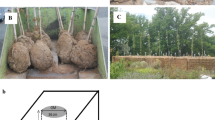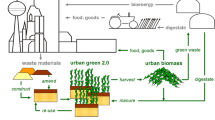Abstract
Purpose
The densification and expansion of urban areas will increase the streams of waste materials such as bricks, concrete and street sweeping waste. In parallel, green areas offer the potential to overcome many challenges that face growing/expanding cities but require the use of large amounts of natural resources such as natural topsoil and aggregates. In this work, various waste materials mixed with organic debris are tested for greening applications in urban environments as an alternative to the consumption of natural resources.
Materials and methods
Five combinations of artefacts were studied either as “growing material” (i.e. dedicated to plant growth) or “structural material” (as support for traffic). These constructed Technosols were studied in situ in lysimeters under two sets of contrasting climatic conditions at two sites in France (Angers, oceanic climate, and Homécourt semi-continental climate). They were planted with trees (Acer platanoides) and with ryegrass (Lolium perenne L.).
Results and discussion
Compared to natural soils, the constructed Technosols exhibited high porosities and highly saturated hydraulic conductivities (up to 0.76 m3 m−3, and to 34.74 cm h−1, respectively). The physical properties–i.e. macroporosity and microporosity–of these artificial soils revealed high water supply for plants, with available soil water ranging from 0.5 to 2.9 mm cm−1. Tree and ryegrass roots were able to grow in the entire soil volume available in the lysimeters. Organic matter nature and soil pH conditions appeared to be the main drivers of plant development.
Conclusions
Constructed Technosols are suitable for vegetation growth and constitute a valuable alternative to the consumption of natural arable earth for urban greening applications, e.g. gardens, parks, and tree lines. Furthermore, they can provide high levels of relevant ecosystem functions in cities such as water retention and infiltration, plant settlement, carbon sequestration and even biodiversity habitats.









Similar content being viewed by others
References
ADEME (2012) Les déchets- Chiffres Clés (Edition 2012)
Baetens JM, Verbist K, Cornelis WM, Gabriels D, Soto G (2009) On the influence of coarse fragments on soil water retention. Water Resour Res 45:W07408
Bartens J, Day SD, Harris JR, Wynn TM, Dove JE (2009) Transpiration and root development of urban trees in structural soil stormwater reservoirs. Environ Manag 44:646–657
Bartens J, Wiseman PE, Smiley ET (2010) Stability of landscape trees in engineered and conventional urban soil mixes. Urban For Urban Green 9:333–338
Böhm W (1979) Methods of studying root systems. Springer-Verlag, Berlin
Brakensiek DL, Rawls WJ (1994) Soil containing rock fragments: effects on infiltration. Catena 23:99–110
Cameira MR, Fernando RM, Pereira LS (2003) Soil macropore dynamics affected by tillage and irrigation for a silty loam alluvial soil in southern Portugal. Soil Till Res 70:131–140
Cannavo P, Michel JC (2013) Peat particle size effects on spatial root distribution, and changes on hydraulic and aeration properties. Sci Hortic 151:11–21
Cannavo P, Vidal-Beaudet L, Grosbellet C (2014) Prediction of long-term sustainability of constructed urban soil: impact of high amounts of organic matter on soil physical properties and water transfer. Soil Use Manag 30:272–284
Core Team R (2015) R: a language and environment for statistical computing. R Foundation for Statistical Computing, Vienna, Austria
Cousin I, Nicoullaud B, Coutadeur C (2003) Influence of rock fragments on the water retention and water percolation in a calcareous soil. Catena 53:97–114
Craul PJ (1999) Urban soils, applications and practices. Wiley, New York
Dexter AR (1988) Advances in characterization of soil structure. Soil Till Res 11:199–283
Djedjig R, Bozonnet E, Belarbi R (2013) Experimental study of the urban microclimate mitigation potential of green roofs and green walls in street canyons. Int J Low-Carbon Technol. doi:10.1093/ijlct/ctt019
Grabosky J, Bassuk N (1995) A new urban tree soil to safely increase rooting volumes under sidewalks. J Arboric 21:187–201
Grabosky J, Haffner E, Bassuk N (2009) Plant available moisture in stone-soil media for use under pavement while allowing urban tree root growth. Arboricult Urban For 35:271–278
Hanna K, Lassabatere L, Bechet B (2009) Zinc and lead transfer in a contaminated roadside soil: experimental study and modeling. J Hazard Mater 161:1499–1505
Huot H, Séré G, Charbonnier P, Simonnot MO, Morel JL (2015) Lysimeter monitoring as assessment of the potential for revegetation to manage former iron industry settling ponds. Sci Total Environ 526:29–40
IUSS Working Group WRB. World reference base for soil resources (2014) International soil classification system for naming soils and creating legends for soil maps. Report N°106. FAO, Rome
Kodesova R, Šimůnek J, Nikodem A, Jirku V (2010) Estimation of the dual permeability model parameters using tension disk infiltrometer and Guelph permeameter. Vadose Zone J 9:213–225
Lemaire F, Sorin X, (1996) Artificialisation du milieu de culture dans les espaces verts urbains. In: Les Colloques. La plante dans la ville, Angers (France), 5–7 Novembre 1996, INRA Ed., Angers, France, pp 247–256
Loh FCW, Grabosky JC, Bassuk NL (2003) Growth response of Ficus benjamina to limited volume and soil dilution in a skeletal soil container study. Urban For Urban Green 2:53–62
Ma D, Shao M, Zhang J, Wang Q (2010) Validation of an analytical method for determining soil hydraulic properties of stony soils using experimental data. Geoderma 159:262–269
Mallants D, Jacques D, Tseng PH, van Genuchten MT, Feyen J (1997) Comparison of three hydraulic property measurement methods. J Hydrol 199:295–318
Marquardt DW (1963) An algorithm for least-squares estimation of nonlinear parameters. SIAM J Appl Math 11:431–441
Marshall RE Farahbakhsh K (2013) Systems approaches to integrated solid waste management in developing countries. Waste Management. ISBN: 0470999675
Morel JL, Schwartz Florentin, L. C (2005) Urban soils. Encyclopedia of soils in the environment, Elsevier, pp 202–208
Mualem Y (1976) A new model for predicting the hydraulic conductivity of unsaturated porous media. Water Resour Res 12:513–522
NF EN 933-1 (2012) Essais pour déterminer les caractéristiques géométriques des granulats - Partie 1: détermination de la granularité - Analyse granulométrique par tamisage
NF ISO 10390 (2005) Qualité du sol - Détermination du pH
NF ISO 11263 (1995) Qualité du sol - Dosage du phosphore - Dosage spectrométrique du phosphore soluble dans une solution d’hydrogénocarbonate de sodium
NF ISO 13878 (1998) Qualité du sol - Détermination de la teneur totale en azote par combustion sèche (“analyse élémentaire”)
NF ISO 14235 (1998) Qualité du sol - Dosage du carbone organique par oxydation sulfochromique
NF P94-054 (1991) Sols : reconnaissance et essais - Détermination de la masse volumique des particules solides des sols - Méthode du pycnomètre à eau
Nielsen TS, Hansen KB (2007) Do green areas affect health? Results from Danish survey on the use of green areas and health indicators. Health Place 13:839–850
Novak V, Knava K, Simunek J (2011) Determining the influence of stones on hydraulic conductivity of saturated soils using numerical method. Geoderma 161:177–181
Ojeda G, Mattana S, Bonmati M, Woche SK, Bachmann J (2011) Soil wetting-drying and water-retention properties in a mine-soil treated with composted and thermally-dried sludges. Eur J Soil Sci 62:696–708
Pagliai M, Vignozzi N (2002) Soil pore system as an indicator of soil quality. In: Pagliai M, Jones R (eds) Sustainable soil management for environmental protection. Soil physics aspects. Catena, Reiskirchen, pp. 71–82
Poesen J, Lavee H (1994) Rock fragments in top soils: significance and processes. Catena 23:1–28
Ramos TB, Goncalves MC, Martins JC, van Genuchten MT, Pires FP (2006) Estimation of soil hydraulic properties from numerical inversion of tension disk infiltrometer data. Vadose Zone J 5:684–696
Recous S. (1995) Réponse des matières organiques des sols aux changements atmosphériques globaux. II. Effet de la température sur la minéralisation d’un résidu végétal (maïs) et de la matière organique des sols. In: Perrier A, Saugier B (eds) Dossiers de l’environnement de l’INRA n°8, Paris, pp 81–86
Rokia S, Séré G, Schwartz C, Deeb M, Fournier F, Nehls T, Damas O, Vidal-Beaudet L (2014) Modelling agronomic properties of Technosols constructed with urban wastes. Waste Manag 34:2155–2162
Sarah P (2002) Spatial patterns of soil moisture as affected by shrubs, in different climatic conditions. Environ Monit Assess 73:237–241
Schaap MG, Leij FJ, van Genuchten MT (2001) ROSETTA: a computer program for estimating soil hydraulic parameters with hierarchical pedotransfer functions. J Hydrol 251:163–176
Schwartz RC, Evett SR (2002) Estimating hydraulic properties of a fine textured soil using a disc infiltrometer. Soil Sci Soc Am J 66:1409–1423
Seber GAF, Wild CJ (2003) Nonlinear regression. Wiley, New York
Séré G, Ouvrard S, Magnenet V, Pey B, Morel JL, Schwartz C (2012) Predictability of the evolution of the soil structure using water flow modeling for a constructed technosol. Vadose Zone J 11 0-0
Séré G, Ouvrard S, Schwartz C, Renat JC, Morel JL (2008) Soil construction: a step for ecological reclamation of derelict lands. J Soils Sediments 8:130–136
Séré G, Schwartz C, Ouvrard S, Renat JC, Watteau F, Villemin G, Morel JL (2010) Early pedogenic evolution of constructed Technosol. J Soils Sediments 10:1246–1254
Šimůnek J, van Genuchten MT (1996) Estimating unsaturated soil hydraulic properties from tension disc infiltrometer data by numerical inversion. Water Resour Res 32:2683–2696
Simůnek J, van Genuchten MT (1997) Estimating unsaturated soil hydraulic properties from multiple tension disc infiltrometer data. Soil Sci 162(6):383–398
Šimůnek J, Angulo-Jaramillo R. Schaap MG, Vandervaere JP, van Genuchten MT (1998) Using an inverse method to estimate the hydraulic properties of crusted soils from tension-disc infiltrometer data. Geoderma 86:61–81
Šimůnek J, van Genuchten MT, Sejna M (2008) Development and applications of the HYDRUS and STANMOD software packages and related codes. Vadose Zone J 7:587–600
Tardieu F, Manichon H (1986) Caractérisation en tant que capteur d’eau de l’enracinement du maïs en parcelle cultivée. Agronomie 6:345–354
Tetegan M, Nicoullaud B, Baize D, Bouthier A, Cousin I (2011) The contribution of rock fragments to the available water content of stony soils: proposition of new pedotransfer functions. Geoderma 165:40–49
Ugolini FC, Corti G, Agnelli A, Certini G (1998) Under and overestimation of soil properties in stony soils. 16th World Congress of Soil Science. Montpellier, France
Urban J (2013) Two different approaches to improve growing conditions for trees. Arboricultural Consult 46:5–12
van Genuchten MT (1980) A closed form equation for predicting the hydraulic conductivity of unsaturated soils. Soil Sci Soc Am J 44:892–898
Yilmaz D, Dal L (2015) Hydraulic properties estimation of an experimental urban soil column constructed with waste brick and compost. Int J Pure Appl Sci 1:9–15
Yilmaz D, Lassabatere L, Deneele D, Angulo-Jaramillo R, Legret M (2013) Influence of carbonation on the microstructure and hydraulic properties of a basic oxygen furnace slag. Vadose Zone J. doi:10.2136/vzj2012.0121
Yuan HP, Shen LY (2011) Trend of the research on construction and demolition waste management. Waste Manag 31:670–679
Zhou BB, Shao MA, Shao HB (2009) Effect of rock fragments on water movement and solute transport in a loess plateau soil. C R Géosci 341:462–472
Acknowledgments
This study was conducted as part of the SITERRE project funded by the ADEME Environmental Agency. The authors would also like to thank Y. Barraud-Roussel, S. Delepine-Bourgeois, C. Mazzega, D. Lemesle, L. Pineau, R. Baldo and M. Malacarne for their valuable assistance in carrying out the experiments and collecting the data.
Author information
Authors and Affiliations
Corresponding author
Additional information
Responsible editor: Fanghua Hao
Rights and permissions
About this article
Cite this article
Yilmaz, D., Cannavo, P., Séré, G. et al. Physical properties of structural soils containing waste materials to achieve urban greening. J Soils Sediments 18, 442–455 (2018). https://doi.org/10.1007/s11368-016-1524-0
Received:
Accepted:
Published:
Issue Date:
DOI: https://doi.org/10.1007/s11368-016-1524-0




